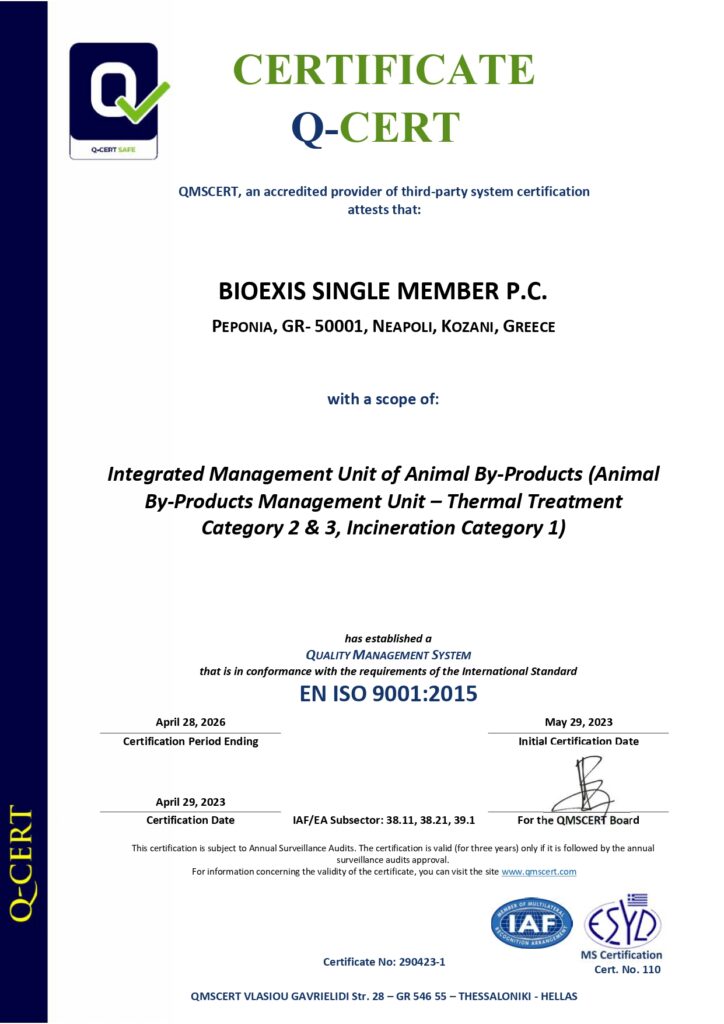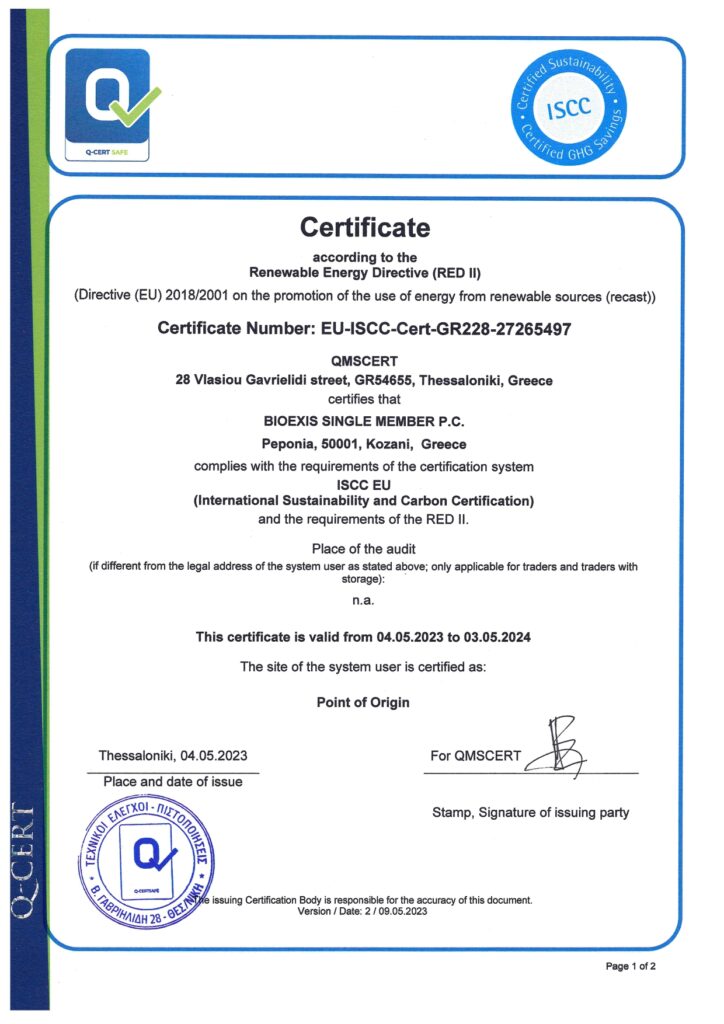About Us
“BIOEXIS” was founded in 2008 with registered seat in Kastoria (at 9 Endekatis Noemvriou Str.) and operates in its new facilities in the area of Neapolis of Kozani (at 7th km of the Neapolis – Kivotos Road) since 2013.
The object of its activity is the collection and management of animal by-products.
It has the following units:
- Rendering plant for category 3 by-products (three production lines) with veterinary approval code 273Y3EL58M, of a capacity of 300 tns per day.
- Rendering plant for category 2 by-products (one production line) with veterinary approval code 215Y2EL58M, of a capacity of 20 tns per day.
- High-capacity incineration plant, with veterinary approval code 485Y123EL58HP, of a capacity of 45 tns per day.
The aforementioned units are housed in industrial buildings and auxiliary spaces of area of 25,000 sq.m. on a privately owned plot of area of 60,000 sq.m.
These are state-of-the-art innovative facilities, that are constantly being modernised, in pace with high technology progress and standards and in an environmentally friendly way.
Animal by-products
Animal by-products, in accordance with Regulation 1069 of the European Parliament and of the Council of 21 October 2009 and Regulation 142/2011 of the European Commission of 25 February 2011, are:
“Entire bodies or parts of animals, products of animal origin or other products obtained from animals, which are not intended for human consumption.”
Animal by-products are divided into:
(a) Animal by-products “by law” which, according to Community legislation, are prohibited for human consumption
and
(b) Animal by-products “by choice” which are raw materials for products of animal origin or products of animal origin, which may be intended for human consumption under Community legislation, but by irrevocable decision of the responsible producer of such products, are intended for purposes other than human consumption.
The categorisation of animal by-products is made into three specific categories, based on the level of risk they entail for public health, animal health and the environment, as follows:
Category 1, which refers to the highest risk materials (prohibited substances, environmental contamination).
Category 2, which refers to intermediate risk materials (microbiological agents or residues of pharmaceutical substances).
Category 3, which refers to low risk materials (derived from healthy animals or health appropriate former animal products).
In summary, the Key producers of animal by-products and derived materials produced on their premises are:
- Ports, Airports
Food waste from international transport, kitchen waste, but also food transferred by passengers and crew with their luggage, from third countries for personal use and which is confiscated.
2. Zoos, Circuses and Pet Shelters
Dead animals.
3. Farmed livestock holdings - units
Dead animals.
4. Slaughterhouses/Poultry Slaughterhouses
Dead animals that died during transport
Blood
Specific risk material (as regards bovine animals: the upper part of the skull, spinal cord, spine, tonsils and intestines, and as regards ovine and caprine animals: the skull, tonsils, spinal cord, spleen and ileus).
Confiscated carcasses, organs or tissues
Non edible tissues and organs of the carcase
Manure and contents of the digestive tract
Skin
5. Incubators
Eggs
Egg shells
6. Cutting - Packaging Plants
Tissues discarded for health reasons
Tissues discarded for commercial reasons
Bones - Fat
7. Milk processing facilities
Quantities of products declared unfit for human consumption, for health reasons
Acid whey, whey, cheese, yoghurt, commercially defective lots, shelf life expiry
8. Food Retailers
Former foodstuffs of animal origin and products of animal origin diverted from the human food chain for any reason, e.g. commercial reasons or defective packaging, for health reasons (deterioration of organoleptic characteristics – shelf life expiry), product recall
9. Butchers' shops
Bones, discarded tissues, fat
10. Fish markets – Fishmongers
Unfit fish for commercial reasons
11. Restaurants – Catering Establishments - Hotels
Food waste, cooking oil
The food crises of the past two decades have underlined the role of animal by-products not intended for human consumption in the spread of certain contagious diseases. Following the global outbreak of bovine spongiform encephalopathy and avian disease, the rendering of animal by-products became mandatory pursuant to Regulation 1069/2009 of the European Parliament (Regulation 142/2011 of the European Commission).
Our experience and consistency has established our name as the leading company for animal by-product collection and management in Greece.
Certificates

Copyright © 2021 | Animal by-product rendering - BIOEXIS. All rights reserved.



